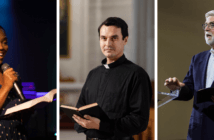Lovett H. Weems, Jr., reviews Leading Ideas research that shows that fewer young persons are entering ordained ministry in mainline denominations.
It is easy for mainline congregations to take for granted the presence of an educated church leadership, ever being refreshed by new young persons entering the ranks of the ordained. That may be changing. Today many denominations are facing a new challenge. As their need for more compelling and creative leadership grows, they are seeing fewer young persons enter ordained ministry.
Recent research by the Lewis Center for Church Leadership in cooperation with denominational agencies indicates some deeply troubling trends about the numbers and percentages of clergy under the age of 35 in many denominations. In the United Methodist Church there has been a dramatic drop in the number and percentage of elders under the age of 35 in the last twenty years. The number of elders under 35 declined from 3,219 in 1985 to 850 in 2005. Young elders as a percentage of all elders dropped from 15.05% in 1985 to only 4.69% in 2005. For example, the annual conference with the highest percentage of young elders today has 10%, still five percent below where the whole denomination was just twenty years ago.
Other mainline denominations show similar trends as indicated by the figures below.
|
Clergy Age Comparison Across Denominations |
||||||||
|
Percentage |
||||||||
|
Denomination |
ABC |
DOC |
Episcopal |
ELCA |
|
PC |
UMC |
|
|
Year |
2006 |
2006 |
2006 |
2005 |
|
2002 |
2005 |
|
|
Under 35 |
5.50% |
5.53% |
4.10% |
4.86% |
7.10% |
4.69% |
||
|
35 – 54 |
53.41% |
50.79% |
46.60% |
49.28% |
59.20% |
54.41% |
||
|
55 and older |
41.09% |
43.68% |
49.30% |
45.96% |
33.70% |
40.90% |
||
|
Numbers |
||||||||
|
Denomination |
ABC |
DOC |
Episcopal |
ELCA |
|
PC |
UMC |
|
|
Year |
2006 |
2006 |
2006 |
2005 |
|
2002 |
2005 |
|
|
Under 35 |
322 |
223 |
286 |
502 |
699 |
850 |
||
|
35 – 54 |
3,128 |
2,142 |
3,216 |
5,090 |
5,818 |
9,872 |
||
|
55 and older |
2,406 |
1,842 |
3,403 |
4,736 |
3,312 |
7,419 |
||
The patterns among these mainline denominations are remarkably similar. Other denominations are experiencing somewhat different patterns. The Church of the Nazarene has almost 13% of its clergy under 35 while Roman Catholic priests under 35 make up only 3% of U.S. priests.
The Challenge
This unfortunate trend is the result of decades of organizational decline. The leadership base of declining organizations gets smaller and smaller, and they fail to attract quality young leaders. So just at the time when the organization needs its best leaders in greatest numbers, the base of new and quality leadership tends to be smallest. Judicatory procedures and seminary curricula are not the major stumbling blocks keeping young people from considering ordination. Most never get that far since they are no longer in our churches. The church’s overall health is the most important factor determining who comes into ordained ministry. Organizations tend to get the leadership they deserve, not the leadership they need.
Thus, the issue of enlisting younger quality clergy must be seen side by side with the quality and vitality of the church itself. Our efforts and our futures are tied to the renewal and revitalization of the church and its leadership. Any questions or concerns about the quality of leadership must be directed at the church itself – why the church in this particular era allows so many to ignore the call of God.
Enlistment – A Calling of the Whole Church
God is still calling persons of all ages, including young persons, to ordained ministry. Yet it is apparent that all parts of the church need to work together to encourage and support persons in hearing and responding to this call. The responsibility for identification and enlistment for ordained ministry is shared by laity, clergy, judicatories, denominational leaders and agencies, and seminaries. All have some part in encouraging and guiding those who seek to serve God through ordained ministry.
This is no time for blame. It is time to acknowledge a dilemma and become partners in its resolution. Positive efforts are already underway in most denominations. Many are finding young people very open to considering God’s call on their lives.
Perhaps we should all remember the words of a seminary president who said in 1905 that the principal reason why young people “of the highest qualifications are not entering the ministry in larger numbers is the lack of definite, earnest, prayerful efforts to influence them to devote themselves to this calling.”
What’s At Stake?
There is no more important task before Christians today than the enlistment and education of leaders for the church. The future of the church depends upon our ability to enlist and prepare committed and capable candidates for ministry. In the coming years, a high percentage of current pastors must be replaced. Even more important than the replacement issue is the church’s need for clergy of outstanding gifts to meet the challenges of today and tomorrow. At the most important level this is about the very future of the church, and developing that leadership which the church deserves.
Ordained ministry is perhaps the most challenging and demanding of all vocations. It can also be the most rewarding and fulfilling. When done well, there is nothing more wonderful to behold. Indeed, there is no higher calling. And there is no greater responsibility than to be involved as we all can be in the enlistment, encouragement, education, guidance, and approval of persons seeking to give their lives to God through ordained ministry.
Related Resources







